Yoga, an age-old discipline, has been embraced worldwide for its incredible benefits to the body and mind. This guide introduces beginners to the fundamental yoga poses, like the downward dog yoga pose, that form the core of many yoga practices. Whether you want to improve your flexibility, strength, and balance or simply seek a moment of tranquillity in your busy day, these basic yoga poses are an excellent starting point. Discover the power of yoga and begin your journey to enhanced well-being right here.
Yoga Fundamentals
The Significance of Breathing Techniques in Yoga
Breathing techniques in yoga hold immense importance in practice. These techniques are built on the foundation of controlling and directing our breath, considered the source of our life force. Proper breathing helps maintain focus during yoga and allows a deeper connection between the mind, body, and spirit. It aids in reducing stress and promoting relaxation, thereby enhancing the overall yoga experience. Establishing a steady, rhythmic breath is essential for novice and experienced practitioners as it forms the backbone of any successful yoga practice.
The Importance of Alignment and Posture in Yoga
Alignment and posture play a crucial role in the practice of yoga. The correct alignment in yoga poses not only maximises the benefits of the practice but also minimises the risk of injury. It ensures that the body works efficiently, distributing the effort evenly across various body parts. Conversely, proper posture is instrumental in maintaining balance, enhancing focus, and promoting better breathing. Maintaining a good posture during yoga allows for a more open chest and efficient use of muscles, making breathing techniques easier to execute.
The Principle of Mindfulness and Presence during Practice
The principle of mindfulness and presence is a cornerstone in yoga practice. Mindfulness involves maintaining a moment-by-moment awareness of our thoughts, feelings, bodily sensations, and surrounding environment. By being fully present in each posture, one can deeply connect with the self and experience the essence of each pose. It means letting go of distractions or thoughts about the past or future and fully immersing oneself in the present. This conscious presence provides a pathway to achieve inner calm and balance, enriching the holistic benefits of yoga.
Warm-Up Poses
Child’s Pose
To perform this pose:
- Begin by kneeling on your mat with your toes together and your knees hip-width apart.
- Lean forward to drape your torso between your thighs, laying your hands on the floor alongside your torso with your palms facing up.
- Rest your forehead on the floor and breathe deeply, allowing your back to soften and your hips to sink back towards your heels.
Cat-Cow Pose
Cat-Cow Pose is a gentle flow between two poses that warms the body and brings flexibility to the spine. It is often used as a warm-up at the beginning of a yoga practice. To start:
- Come to a hands-and-knee position.
- Ensure your knees are set directly below your hips, and your wrists, elbows and shoulders are in line and perpendicular to the floor.
- As you inhale, lift your sitting bones and chest towards the ceiling, allowing your belly to sink towards the floor (Cow Pose).
- As you exhale, round your spine towards the ceiling, keeping your knees and shoulders in place (Cat Pose).
Downward-Facing Dog
Downward-Facing Dog is one of the most widely recognised yoga postures, but it’s also complicated.
- Begin on your hands and knees, align your wrists directly under your shoulders and your knees under your hips.
- Press your palms into the mat and raise your hips toward the ceiling, straightening your legs to form an inverted ‘V’ shape with your body.
- Keep your head between your upper arms, gazing towards your navel.
This pose helps to strengthen the arms and shoulders, stretch the hamstrings, calves, and arches, and energise the body.
Standing Poses
Mountain Pose
Mountain Pose is a foundational yoga pose that helps improve posture, balance, and focus. To begin:
- Stand tall with your feet hip-width apart. Distribute your weight evenly across both feet, grounding your soles fully into the floor.
- Pull your shoulder blades back and down, keeping your spine straight and your chin parallel to the floor.
- Extend your arms alongside your body, with your palms facing forward.
- Breathe deeply, calming your mind and strengthening your body.
This pose may appear simple, but it is a powerful grounding technique often used as a starting pose for other standing postures. Practising this pose near a wall may be beneficial if you have balance issues.
Warrior I & II
To perform this pose:
- Start with Mountain Pose.
- Step your feet about 4 feet apart, turning your right foot out 90 degrees and your left foot in slightly.
- Raise your arms perpendicular to the floor, and reach actively from fingertip to fingertip.
- Turn your torso to the right, and square your hips as much as possible with the front edge of your mat.
- Bend your right knee over the right ankle so the shin is perpendicular to the floor.
- If possible, bring the right thigh parallel to the floor.
- Hold for 30 seconds to a minute, then release, reverse the feet and repeat for the same length to the left.
From the last pose:
- Keep your front knee bent and rotate your torso to the left.
- Extend your arms to the sides, parallel to the floor, actively reaching your fingers away from each other.
- Turn your head to look out over your right hand.
- Keep your back leg straight and your spine neutral. This pose stretches your hips, strengthens your legs, and helps to build stamina.
- To release, drop your arms and straighten the front knee. Repeat on the other side.
As with all poses, remember to breathe deeply and mindfully. If you suffer from neck problems, don’t turn your head to look over the front hand; look straight ahead with both sides of the neck lengthened evenly.
Triangle Pose
The Triangle Pose is another foundational standing pose that enhances strength, balance, and flexibility. To perform it:
- Begin from Warrior II.
- Straighten your front knee.
- Lean forward, bringing your right hand down to rest on your shin, ankle, or the floor, depending on your level of flexibility.
- Extend your left arm up to the ceiling, keeping both arms in one straight line.
- Turn your gaze towards your left hand, ensuring your chest is open, and your body is evenly distributed over both legs. This pose stretches the legs, back, and hips, strengthen the thighs, knees, and ankles, and can help alleviate stress.
- To release, rise back up, reverse the feet and repeat on the other side.
Seated Poses
Easy Pose
The Easy Pose is a common meditation and breathing exercise posture. It’s simple yet powerful, promoting inner calm and grounding.
To perform:
- Sit on the edge of a firm blanket with your legs extended before you.
- Cross your shins, widen your knees, and bring each foot beneath the opposite knee. You should aim to balance your weight evenly across your sit bones.
- Rest your hands on your knees, palms down.
- Keep your spine straight, broaden your chest, and gently draw your shoulders back.
- Relax your body and breathe deeply.
This pose helps to open the hips, lengthen the spine, and cultivate tranquillity. Extend both legs out in front of you to release from the pose.
Butterfly Pose
The Butterfly Pose is a seated posture that deeply stretches the hips and groin. To begin:
- Sit on your mat with your legs extended in front of you.
- Then, bend your knees, bringing your feet towards your pelvis.
- Let the soles of your feet touch each other, and gently drop your knees out to the sides.
- Hold your feet or ankles with your hands, ensuring your spine is straight and tall.
- Avoid pushing your knees downward; instead, let gravity do the work.
- Allow your breath to deepen and your body to relax with each exhale.
This pose improves flexibility, stimulates abdominal organs, and reduces stress and fatigue. To release from the pose, gently lift your knees and extend your legs before you.
Tips for Beginners
Importance of listening to one’s body
Engaging in yoga requires a deep understanding and connection with one’s body. It is essential to listen to what your body tells you to prevent injury and get the most out of your practice. Recognise the difference between discomfort, which can be a sign of beneficial stretching, and pain, which indicates that a pose might be too challenging or performed incorrectly.
Additionally, understanding your energy levels and emotional state before starting your practice can help you choose the best poses for that day. Beginners should also remember that progress in yoga is not about achieving the perfect pose but about the journey and the increased awareness of one’s body and mind.
The value of consistency over intensity
Consistency in yoga practice is far more crucial than intensity. It’s not about pushing your body to its limits in every session but about regular, consistent practice, whether daily or several times a week. Consistency allows the body and mind to gradually adapt, build strength and flexibility, and better understand each pose’s benefits.
Moreover, it cultivates discipline and establishes yoga as a habit, integral to reaping its full benefits. Remember, yoga is not a race or a competition—it’s a personal journey of growth and mindfulness.
Bottomline
Embracing yoga signifies a commitment to overall well-being, a journey of self-discovery, harmony, and tranquillity. As you embark on this journey with these basic poses, remember to stay patient with yourself—progress might be slow, but it’s significant.
Consistency and mindfulness are crucial to transforming our physical health and emotional resilience. And above all, yoga is a celebration of what your body and mind can achieve. So, unroll your mat, breathe deeply, and let your yoga journey unfold. Remember, it’s not about perfecting the pose—it’s about the path you take to get there.
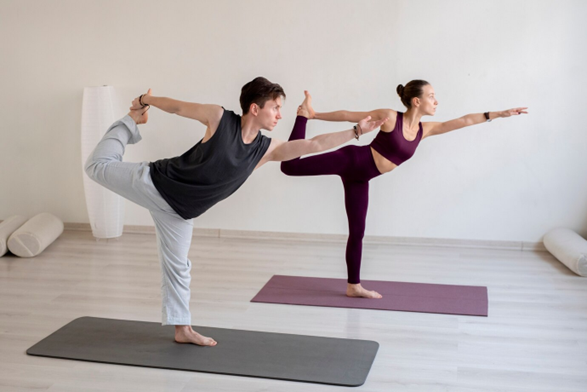
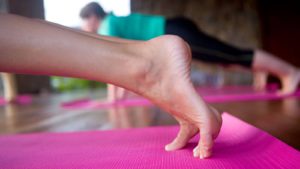
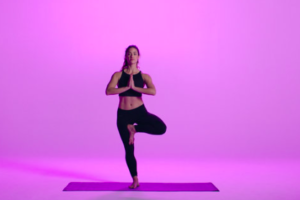
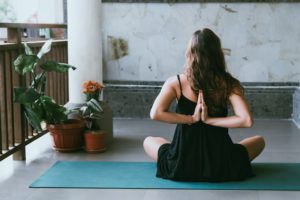
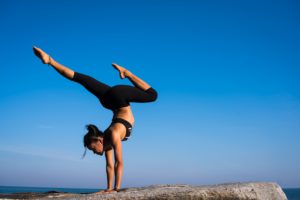
Be First to Comment